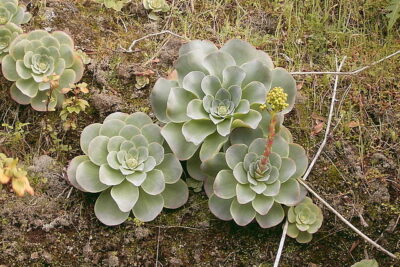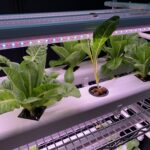
Can Succulents Thrive Indoors Without Sunlight?

Succulents have become incredibly popular in recent years, loved for their unique and eye-catching appearance. These plants are known for their ability to store water in their leaves, stems, and roots, allowing them to survive in dry and arid conditions. While succulents are typically associated with thriving in sunny and bright outdoor environments, many people wonder if they can also flourish indoors without direct sunlight.
We will explore whether succulents can thrive indoors without sunlight. We will discuss the natural habitat of succulents and the factors that contribute to their growth. Additionally, we will provide tips and guidelines for successfully growing succulents indoors, including the type of lighting they need, suitable containers, and proper watering techniques. By the end of this article, you will have a better understanding of how to care for your indoor succulents and ensure they receive the necessary conditions for optimal growth.
- Yes, succulents can thrive indoors without direct sunlight
- Place the succulents near a bright window that receives indirect sunlight
- Use artificial grow lights to provide the necessary light for succulents
- Rotate the succulents regularly to ensure even light exposure
- Choose low-light tolerant succulent varieties for indoor cultivation
- Monitor the soil moisture and avoid overwatering to prevent root rot
- Provide adequate air circulation to prevent the growth of mold and fungus
- Use well-draining soil specifically formulated for succulents
- Consider using a humidifier to maintain the right level of humidity indoors
- Avoid placing succulents in drafty areas or near heating or cooling vents
- Frequently Asked Questions
Yes, succulents can thrive indoors without direct sunlight
While most succulents are known for their ability to thrive in sunny, arid climates, there are actually many varieties that can survive and even thrive indoors without direct sunlight. This is great news for those of us who don't have access to abundant natural light or live in areas with long, dark winters.
One important thing to keep in mind is that even though succulents can survive without direct sunlight, they still need some light to grow and remain healthy. So, while you don't need to place them in a spot with intense sunlight, you should still provide them with bright, indirect light.
Choosing the right succulents for low-light conditions
Not all succulents are suited for low-light environments. Some varieties are more adaptable and can handle lower light levels better than others. Here are a few succulents that are known to thrive indoors with less sunlight:
- Zebra Haworthia: With its striking white stripes, the Zebra Haworthia is not only a visually appealing succulent but also one that can tolerate low light conditions.
- Sansevieria: Also known as Snake Plant or Mother-in-law's Tongue, the Sansevieria is a popular choice for indoor gardening due to its ability to tolerate low light and neglect.
- Echeveria: These rosette-shaped succulents come in a variety of colors and can adapt well to indoor environments with moderate light.
Providing the right conditions for indoor succulents
In addition to choosing the right succulents for low-light conditions, there are a few other factors to consider when caring for indoor succulents:
- Watering: Succulents are known for their ability to store water in their leaves, so they don't require frequent watering. However, it's important to let the soil dry out completely between waterings to prevent root rot.
- Soil: Use a well-draining soil mix specifically formulated for succulents. This will prevent water from sitting in the roots and causing rot.
- Temperature and humidity: Succulents generally prefer temperatures between 60-80°F (15-27°C) and low to moderate humidity. Avoid placing them near drafts or in overly humid areas.
By choosing the right succulents and providing them with the proper care, it is indeed possible to create a thriving indoor succulent garden without direct sunlight. So, don't let limited access to sunlight stop you from enjoying these unique and fascinating plants!
 Can Succulents Flourish with Grow Lights?
Can Succulents Flourish with Grow Lights?Place the succulents near a bright window that receives indirect sunlight
Succulents are known for their ability to thrive in bright, sunny conditions. However, not all of us have access to the ideal amount of sunlight, especially when it comes to indoor gardening. So, can succulents survive indoors without direct sunlight? The answer is yes, but with some conditions.
One of the most important factors to consider when growing succulents indoors is their exposure to light. While they may not be able to tolerate direct sunlight indoors, they still require a good amount of light to thrive. Therefore, it is crucial to place your succulents near a bright window that receives indirect sunlight.
Indirect sunlight refers to the light that is filtered or diffused, rather than direct rays from the sun. Placing your succulents near a window that receives this kind of light will provide them with the necessary energy for photosynthesis without the risk of sunburn or overheating.
Here are a few tips to ensure your succulents receive enough light indoors:
- Choose a window with an eastern or western exposure, as these provide the best indirect sunlight throughout the day.
- If your succulents are not getting enough light, you can supplement their needs with artificial grow lights. LED grow lights are a popular choice as they emit the right spectrum of light for plant growth.
- Rotate your succulents every few weeks to ensure all sides receive equal light exposure and prevent them from leaning towards the light source.
- Keep an eye on your succulents' leaves. If they start to stretch or become elongated, it is a sign that they are not getting enough light. In this case, adjust their placement or provide additional light.
Remember, while succulents can survive indoors without direct sunlight, they still need a good amount of light to thrive. By placing them near a bright window that receives indirect sunlight and following these tips, you can create a suitable environment for your indoor succulent garden.
Use artificial grow lights to provide the necessary light for succulents
When it comes to growing succulents indoors, one of the main challenges is providing them with enough sunlight. While succulents are known for their ability to thrive in sunny, arid conditions, many indoor environments simply do not receive enough natural sunlight to keep these plants happy and healthy.
 Can Mother of Thousands Succulents Thrive Indoors?
Can Mother of Thousands Succulents Thrive Indoors?However, there is a solution - artificial grow lights. These lights are specially designed to mimic the spectrum of natural sunlight, providing plants with the necessary light they need to thrive. By using artificial grow lights, you can create an indoor oasis for your succulents, even if you don't have access to a sunny window.
Why do succulents need light?
Like all plants, succulents need light for photosynthesis - the process by which they convert light energy into chemical energy to fuel their growth. Without enough light, succulents may become weak, leggy, and pale in color. They may also struggle to produce flowers or even survive.
While some succulents can tolerate lower light conditions than others, most still require several hours of bright, indirect light each day to thrive. This is where artificial grow lights come in handy.
Choosing the right artificial grow lights
When selecting artificial grow lights for your succulents, there are a few key factors to consider. First, look for lights that emit a full spectrum of light, including blue, red, and white wavelengths. This will ensure that your succulents receive all the necessary light for optimal growth.
Next, consider the intensity of the light. Succulents typically require higher light levels than other houseplants, so choose lights that have a high intensity output. This will help to mimic the intensity of natural sunlight and promote healthy growth.
Finally, think about the duration of light exposure. Most succulents benefit from 12-14 hours of light each day. Some grow lights come with built-in timers, which can make it easier to provide your succulents with consistent and appropriate light exposure.
Placement and care
Once you have your artificial grow lights set up, it's important to position them correctly for the best results. Place the lights 6-12 inches above your succulents to ensure they receive adequate light without getting burned. If using multiple lights, make sure they are evenly spaced to provide uniform coverage.
 Growing Succulents on Trees: A Unique Outdoor Garden Idea
Growing Succulents on Trees: A Unique Outdoor Garden IdeaAdditionally, keep in mind that succulents still need a period of darkness for optimal growth. Avoid leaving the lights on 24/7 and instead, provide your succulents with a regular light-dark cycle. This will help them maintain their natural rhythm and promote healthy growth.
Lastly, remember to monitor your succulents closely and adjust the light exposure as needed. Each succulent species has different light requirements, so pay attention to any signs of stress, such as stretching or discoloration, and adjust the light intensity or duration accordingly.
With the right artificial grow lights and proper care, your indoor succulents can thrive without natural sunlight. So go ahead, create a beautiful succulent display in any corner of your home!
Rotate the succulents regularly to ensure even light exposure
One of the most important factors to consider when growing succulents indoors is light exposure. While succulents are known for their ability to thrive in sunny and dry conditions, not all indoor environments can provide the same amount of sunlight. However, with proper care and attention, you can still successfully grow succulents indoors even without direct sunlight.
Rotate the succulents regularly: Succulents require bright, indirect light to maintain their vibrant colors and compact growth. If you have a window that receives limited sunlight, it is essential to rotate your succulents regularly. This will help ensure that all sides of the plant receive an equal amount of light exposure. By rotating them every two weeks, you can prevent your succulents from leaning towards the light source and encourage even growth.
Consider using artificial light: If you don't have access to a window that provides sufficient light, or if you live in a region with limited natural sunlight, you can supplement it with artificial light. LED grow lights are an excellent option for indoor succulents as they produce a full spectrum of light similar to the sun. Place the grow lights above the succulents and adjust the height according to the specific light requirements of the succulent species you are growing.
 Easy Tips for Indoor Succulent Care: A Guide to Succulent Success!
Easy Tips for Indoor Succulent Care: A Guide to Succulent Success!Monitor the temperature and humidity: Succulents thrive in warm and dry conditions. Ensure that the indoor temperature and humidity levels are suitable for their growth. Avoid placing succulents near drafts or heating vents, as sudden changes in temperature can stress the plants. Maintaining a consistent temperature between 60-75°F (15-24°C) and a humidity level of around 40-50% will help create an ideal environment for their growth.
Use well-draining soil: Succulents are prone to root rot if their soil is consistently moist. Therefore, it is crucial to use a well-draining soil mix specifically formulated for succulents. These mixes typically contain materials like perlite, pumice, or coarse sand, which enhance drainage and prevent excess water retention. Avoid using regular potting soil, as it tends to retain moisture for longer durations.
Water sparingly: Overwatering is one of the most common mistakes made when growing succulents indoors. Succulents have adapted to survive in arid environments and store water in their leaves and stems. Therefore, they have a low water requirement. Water your succulents only when the soil is completely dry, and be sure to soak the soil thoroughly during watering sessions. Allow the excess water to drain out of the pot to prevent waterlogged roots.
Fertilize minimally: Unlike other houseplants, succulents do not require frequent fertilization. In fact, applying too much fertilizer can lead to weak, leggy growth and damage the plant. Use a balanced, water-soluble fertilizer specifically formulated for succulents. Apply the fertilizer sparingly, following the instructions provided by the manufacturer.
By following these care tips and providing suitable light conditions, your succulents can thrive indoors without direct sunlight. Remember to observe your plants closely and make any necessary adjustments to ensure their well-being. With a little attention and care, you can enjoy a stunning collection of succulents right in your own home.
Choose low-light tolerant succulent varieties for indoor cultivation
When it comes to cultivating succulents indoors, one common concern is whether these sun-loving plants can thrive without direct sunlight. While it's true that most succulents prefer bright, indirect light, there are several low-light tolerant varieties that can be successfully grown indoors.
 Can Succulents Survive Outdoors All Year?
Can Succulents Survive Outdoors All Year?1. Zebra Haworthia (Haworthia fasciata)
One of the most popular low-light succulents is the Zebra Haworthia. This striking succulent features dark green leaves with white horizontal stripes, resembling a zebra's skin. It can tolerate low light conditions and requires minimal care, making it an excellent choice for indoor cultivation.
2. Snake Plant (Sansevieria trifasciata)
The Snake Plant, also known as Mother-in-Law's Tongue, is another succulent that thrives in low-light environments. Its long, upright leaves come in various shades of green and yellow, adding a touch of elegance to any indoor space. Snake Plants are not only low-light tolerant but also known for their air-purifying properties, making them a popular choice among indoor gardeners.
3. Ponytail Palm (Beaucarnea recurvata)
Despite its name, the Ponytail Palm is not a true palm tree but a succulent. It features a characteristic swollen trunk and long, cascading leaves that resemble a ponytail. This hardy succulent can tolerate low light conditions and requires infrequent watering, making it a great choice for those who tend to forget about their plants.
4. Aloe Vera (Aloe barbadensis)
Aloe Vera is a versatile succulent known for its medicinal properties and low maintenance requirements. While it prefers bright, indirect light, it can adapt to lower light conditions. Aloe Vera plants are also renowned for their ability to purify the air and can be a beautiful addition to any indoor garden.
Remember, even though these succulents can tolerate lower light levels, it's still important to provide them with as much natural light as possible. Placing them near a north-facing window or providing supplemental grow lights can help ensure their optimal growth and health.
So, if you're looking to cultivate succulents indoors but lack access to direct sunlight, don't worry! There are plenty of low-light tolerant varieties that can thrive in your indoor space.
Monitor the soil moisture and avoid overwatering to prevent root rot
 Can a Star Flower Succulent Survive and Thrive Indoors?
Can a Star Flower Succulent Survive and Thrive Indoors?Succulents are known for their ability to thrive in dry and arid conditions, making them popular houseplants for those with limited access to natural sunlight. While succulents can survive indoors without direct sunlight, it is essential to monitor the soil moisture and avoid overwatering to prevent root rot.
Root rot is a common issue among succulents grown indoors, primarily caused by excessive moisture in the soil. To prevent this, it is crucial to choose well-draining soil specifically formulated for succulents. Such soil allows excess water to flow out of the pot, preventing the roots from sitting in water and rotting.
Additionally, it is advisable to water succulents only when the soil is completely dry. This can be easily determined by sticking your finger about an inch into the soil. If it feels dry, it's time to water. However, if it still feels moist, it's best to wait a few more days before watering again.
When watering your succulents, make sure to soak the soil thoroughly until water drains out of the pot's drainage holes. This ensures that the roots receive enough moisture without being oversaturated. Remember, succulents are adapted to survive in arid conditions, so they can tolerate periods of drought.
In addition to monitoring soil moisture, it is essential to provide your indoor succulents with bright, indirect light. While they don't require direct sunlight, placing them near a window where they can receive bright, filtered light is ideal. This helps to maintain their vibrant colors and prevents them from becoming etiolated or stretched out.
It's important to note that not all succulents are created equal, and some may require more light than others. Research the specific needs of your succulent species to ensure optimal care.
Succulents can indeed thrive indoors without direct sunlight, but it is crucial to monitor the soil moisture and avoid overwatering. By using well-draining soil, watering only when the soil is dry, and providing bright, indirect light, you can enjoy healthy and thriving succulents as indoor houseplants.
 Can Succulents Survive Outdoors in Winter?
Can Succulents Survive Outdoors in Winter?Provide adequate air circulation to prevent the growth of mold and fungus
When growing succulents indoors without sunlight, it is crucial to provide adequate air circulation to prevent the growth of mold and fungus. Succulents thrive in dry conditions, and stagnant air can lead to moisture buildup which creates a favorable environment for mold and fungus to thrive.
To ensure proper air circulation, you can place a small fan near your succulent arrangements. The gentle breeze from the fan will help to keep the air moving and prevent excess moisture from settling on the leaves and soil. Alternatively, you can open windows or use ventilation systems to maintain a constant flow of fresh air.
Another effective way to enhance air circulation is by spacing out your succulents. Avoid overcrowding them, as this can restrict airflow and promote the growth of mold. Give each succulent enough space to breathe and grow freely, allowing air to circulate around the plants.
Additionally, it is essential to regularly inspect your succulents for any signs of mold or fungus. If you notice any, promptly remove the affected leaves or plants to prevent the spread of the problem. This proactive approach will help to maintain a healthy environment for your indoor succulents.
Use well-draining soil specifically formulated for succulents
When it comes to growing succulents indoors without direct sunlight, one of the most important factors to consider is the type of soil you use. Succulents are adapted to arid environments and have unique requirements when it comes to soil moisture. They prefer soil that drains well and doesn't hold excess water, as this can cause root rot and other issues.
 Are Succulents Harmless in Direct Sunlight Throughout the Day?
Are Succulents Harmless in Direct Sunlight Throughout the Day?Opt for a well-draining soil mix specifically formulated for succulents. These mixes are usually composed of a combination of materials like sand, perlite, and peat moss. The sand and perlite provide excellent drainage, while the peat moss retains some moisture to keep the roots hydrated without becoming waterlogged.
When choosing a soil mix, look for options labeled as "succulent soil," "cactus mix," or "well-draining soil." These specialized mixes are designed to provide the ideal growing conditions for succulents, even in indoor environments with limited sunlight.
Remember to repot your succulents every 1-2 years to ensure they have fresh, well-draining soil. Over time, the soil may become compacted or lose its ability to drain properly, which can hinder the plant's growth and overall health.
Consider using a humidifier to maintain the right level of humidity indoors
When it comes to growing succulents indoors without sunlight, one of the key factors to consider is the level of humidity. Succulents are drought-tolerant plants that are adapted to dry and arid environments, so they do not require high levels of humidity like some other houseplants. However, maintaining the right level of humidity is still crucial for their overall health and well-being.
A humidifier can be a great tool to help you maintain the right level of humidity indoors for your succulents. It releases water vapor into the air, increasing the moisture content and creating a more suitable environment for these plants. This is especially important during the winter months when the air tends to be drier due to indoor heating systems.
By using a humidifier, you can mimic the natural conditions that succulents thrive in, even in the absence of sunlight. It helps prevent the leaves from drying out and becoming dehydrated, which can lead to wilted or crispy foliage.
When using a humidifier for your succulents, it's important to keep a few factors in mind:
 Can Succulent Plants Thrive in Low-Light Environments?
Can Succulent Plants Thrive in Low-Light Environments?1. Choose the right type of humidifier
There are various types of humidifiers available in the market, such as ultrasonic, evaporative, or steam humidifiers. Consider the size of your indoor space and the specific needs of your succulents when selecting a humidifier. Ultrasonic humidifiers are generally recommended for indoor plant care as they produce a cool mist without raising the temperature.
2. Place the humidifier strategically
Find a suitable location for your humidifier, ideally near your succulents. Placing it too close to the plants can result in excessive moisture, which can lead to root rot or fungal diseases. On the other hand, placing it too far away may not provide enough humidity for your succulents to benefit from. Experiment with placement until you find the right balance.
3. Monitor humidity levels
Invest in a hygrometer to measure the humidity levels in your indoor environment. Succulents generally thrive in humidity levels between 30% to 50%. Regularly monitor the humidity levels and adjust the settings on your humidifier accordingly. Keeping a consistent humidity level will help your succulents stay healthy and vibrant.
While succulents can survive indoors without direct sunlight, maintaining the right level of humidity is crucial for their well-being. Using a humidifier can help create a suitable environment for these plants, mimicking the conditions they thrive in. Remember to choose the right type of humidifier, place it strategically, and monitor humidity levels to ensure your succulents thrive in your indoor space.
Avoid placing succulents in drafty areas or near heating or cooling vents
When it comes to indoor succulent care, one of the most important factors to consider is the placement of your plants. While succulents are known for their ability to thrive in sunny outdoor environments, it is possible to successfully grow them indoors without direct sunlight. However, to ensure their well-being, it is crucial to avoid placing succulents in drafty areas or near heating or cooling vents.
Succulents are native to arid regions and are adapted to receive a substantial amount of sunlight. When grown indoors, they need to be positioned in a spot that provides them with bright, indirect light. Placing them near a window facing east or west can often provide suitable lighting conditions. However, it is essential to avoid exposing them to direct sunlight, especially during the hottest parts of the day.
 Can Succulents Survive Winter Indoors Without Sunlight?
Can Succulents Survive Winter Indoors Without Sunlight?If you have limited access to natural light or don't have windows facing the right direction, don't worry! There are alternatives to ensure your succulents receive the light they need. You can use artificial grow lights specifically designed for plants. These lights mimic natural sunlight and can be adjusted to provide the ideal spectrum and intensity required for succulent growth.
Although succulents can tolerate lower light conditions for a certain period, extended periods of insufficient light can result in etiolation, a condition where the plant stretches and becomes leggy as it tries to reach for light. To prevent this, it is essential to provide them with adequate light to maintain their compact and attractive form.
- Keep in mind that even though succulents can thrive indoors without sunlight, they still require a period of darkness for proper growth. Therefore, it is crucial to provide them with a regular light-dark cycle.
- Rotate your succulents every few weeks to ensure even exposure to light and prevent them from leaning towards one side.
- Monitor the distance between your succulents and the light source to prevent heat damage. Keep the lights at a safe distance and adjust accordingly as your plants grow.
- Observe your succulents closely for signs of stress or stretching. If you notice any unfavorable changes, adjust their light exposure accordingly.
Remember that while succulents can adapt to lower light conditions, they still need proper care to thrive indoors. In addition to providing suitable lighting, it is crucial to water them correctly, use well-draining soil, and provide adequate airflow to prevent issues such as root rot or fungal diseases.
By following these guidelines and providing your indoor succulents with the right amount of light, you can enjoy their beauty and unique forms while successfully growing them indoors.
Frequently Asked Questions
1. Can succulents thrive indoors without sunlight?
No, succulents need sunlight to thrive. While they can tolerate lower light conditions, they still require several hours of direct or indirect sunlight each day to stay healthy and vibrant.
2. How often should I water my succulents?
Succulents have unique watering needs. They should be watered only when the soil is completely dry, typically every 1-2 weeks. Overwatering can lead to root rot and other issues, so it's important to let the soil dry out between waterings.
3. Can I use regular potting soil for succulents?
No, regular potting soil is not suitable for succulents. They require well-draining soil, so it's best to use a mix specifically formulated for succulents or cacti. These mixes often contain materials like perlite or sand to improve drainage.
4. How often should I fertilize my succulents?
Succulents are not heavy feeders, so they generally don't require frequent fertilization. In general, you can fertilize them once or twice a year during their active growing season, using a balanced fertilizer diluted to half strength.
If you want to read more articles similar to Can Succulents Thrive Indoors Without Sunlight?, you can visit the Indoor and Outdoor Care category.






You Must Read